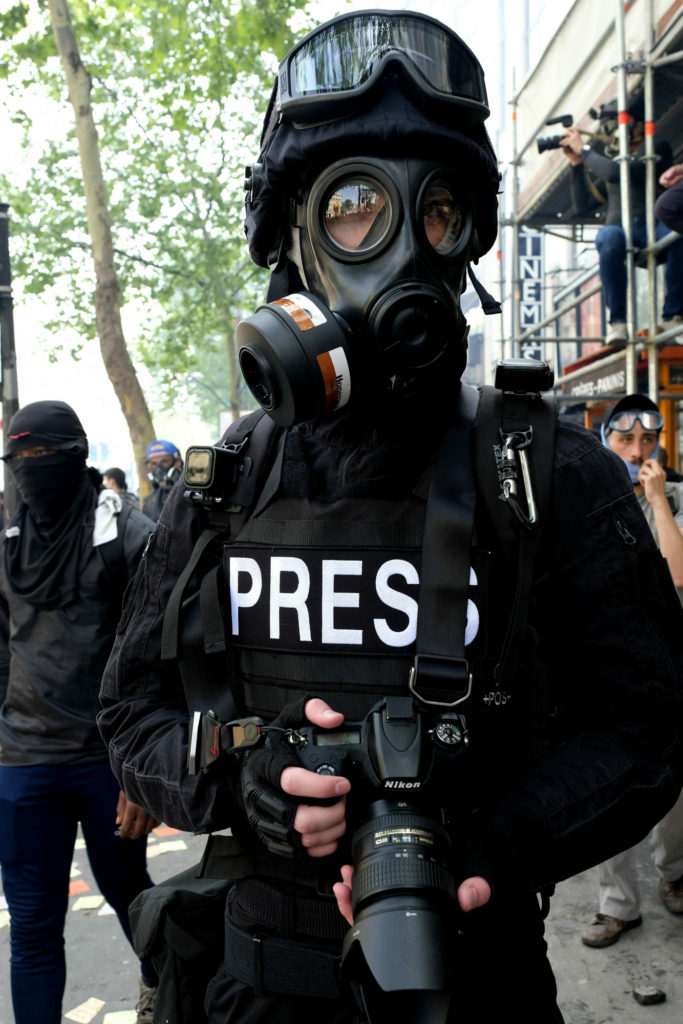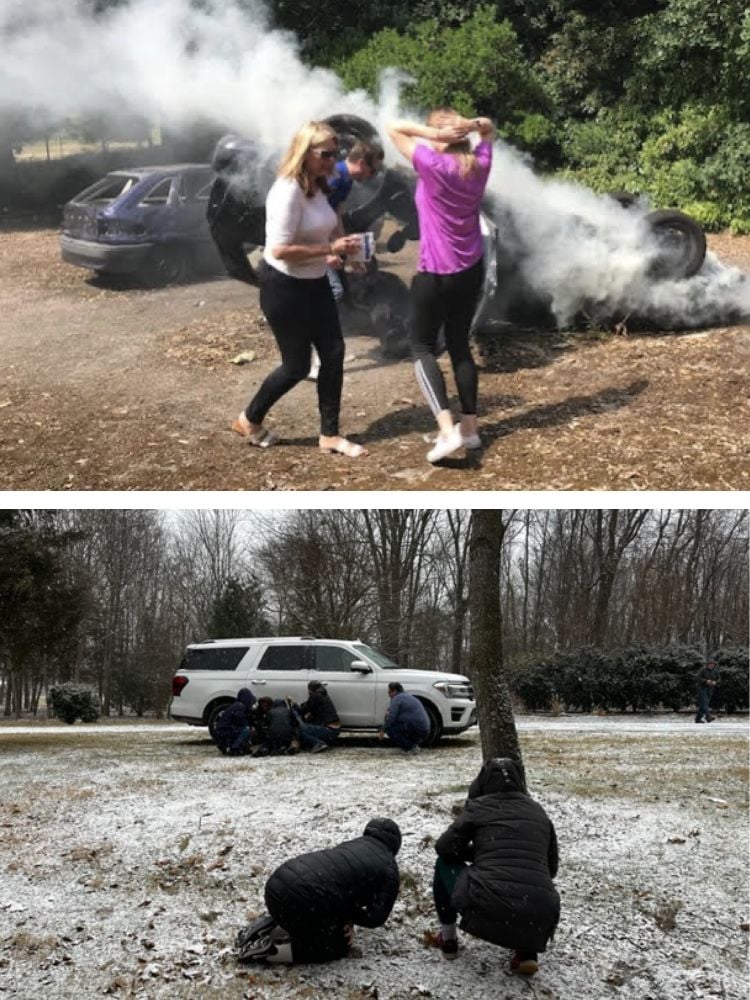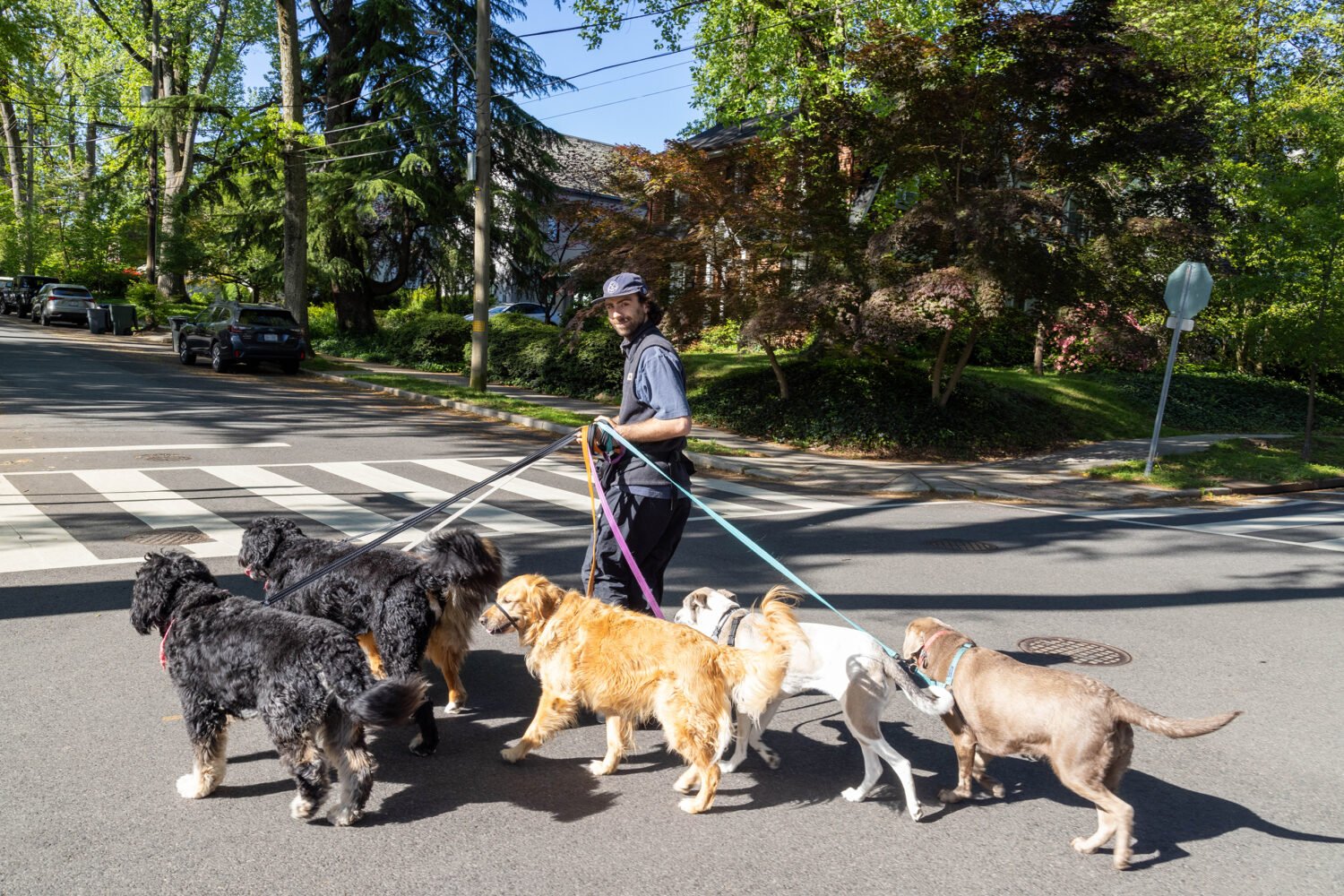
Back in September, I took a bus to Harrisonburg, Virginia, then an Uber into the countryside, to the kind of camp that church and scout groups rent for retreats: clusters of cabins, canoes piled beside a murky pond. When I texted a picture to my husband, he said, “It’s only fun until you get zip-tied.” This wasn’t exactly a joke.
I had come for a course called Hostile Environment & First Aid Training, which helps members of the media navigate the threats they face in their jobs. Over the next four days, a private company that specializes in safety training would teach our group to protect ourselves in riots, detect whether we’re being followed, and stay safe while reporting abroad. We would practice packing fake wounds and crossing pretend checkpoints. One afternoon, our instructors would shoot an AK-47 at a car door to demonstrate that vehicles are bad cover from fire.
In our group were 11 reporters from the Washington Post, plus a cameraman from the British news service ITN. Some of them typically report abroad—in places like Ukraine and Juárez—while others work in the US, covering local politics or breaking news. While out reporting, members of this group had been shot at, kidnapped, and arrested. They were here to learn to survive their jobs.
On the first morning of the course, we ambled from our cabins to a makeshift classroom in the basement of a farmhouse—dingy apricot walls, wood paneling, incongruous fluorescent light. There, we met the instructors. On the security side was Tim, a grizzled ex-cop from Belfast who’d worked in special operations during the Troubles. Our first-aid instructors were Baz, a former British army medic, and Erick, who’d been an EMT on ambulances in DC.
The training, they explained, would be a series of lectures—on topics like hostage situations, artillery fire, and tourniquets—paired with immersive exercises to practice our skills. These scenarios would be lifelike: We’d treat simulated wounds in a dimly lit basement while a recording of gunfire played on a loop, or get carjacked by actors in balaclavas who were screaming and waving fake guns. All of it was meant to cause panic so we could see how we behave under stress.

The course I attended is operated by the Pangolin Group, a UK-based “risk management” firm owned by a former Royal Marine. There’s a whole cottage industry of these companies—many of them British—that run quasi-militaristic survival and medical courses, mostly for media and humanitarian groups. In the American market, Pangolin is among the biggest; outlets like CNN, Bloomberg, the Wall Street Journal, and NPR have all contracted with them, which is why I asked to come along. I don’t personally face much risk at work, but I wanted to see how journalists who do—the kinds who might cover January 6 or Ukraine—would typically prepare.
In one of our first lessons, we applied tourniquets, practicing how to crank them tight. Then, leaving the classroom, I found Erick in the driveway, slumped against a white SUV, grimacing and shrieking and grasping his leg. Beneath his hands was a pretend wound—a plastic chunk of mangled flesh—from which a red-orange liquid spurted, mimicking an arterial bleed. It was obviously fake, but I panicked. I felt that he was going to die.
We’d just been warned about adrenaline—that it’s a problem when treating wounds. Your limbs get shaky. Your fine-motor skills are shot. Tunnel vision leaves you vulnerable to danger because you’re too focused to survey the scene. Ideally, you pause and breathe before you act, but Erick seemed to have lost a lot of blood. I tuned out his babbling—that “it went off in my pants” and “I was just messing around.” The tourniquet from class was still in my hand, so I was busy saving his life.
It wasn’t until I’d finished that I noticed the handgun, shiny and black, lying beside him on the ground. It was pointed right at me, possibly still loaded, its safety presumably off. That was the lesson: that when you fail to manage your adrenaline, you miss obvious dangers. In the real world, I could have been shot.
It’s a perilous time to be a journalist. Since early 2022, at least 17 reporters have died covering the Russian invasion of Ukraine. Then there’s the war in Gaza, whose first ten days claimed an astonishing 19 journalists’ lives. Over the past decade, authoritarian regimes across the globe have gained power while mercilessly targeting the press. Wrongful imprisonments are on the rise, such as the two American reporters currently held captive in Russia or the nine Afghan reporters recently detained in Taliban raids.
Historically, journalists in the United States have been safer—but for decades, public trust in the media has waned. Then, in 2016, Donald Trump ran for President while calling journalists the “enemy of the people,” whipping up widespread antagonism toward the press. Since then, the safety of American journalists has declined. Newsrooms are increasingly worried about issues like assaults, death threats, and arrests.
Because of this, hostile-environment courses have changed. Ten years ago, military-style security training was the province of war correspondents; reporters working in the United States didn’t attend. But today, about 40 percent of the journalists in Pangolin’s courses work in this country, covering mass shootings or political conventions or the Supreme Court.
During one of our sessions, Baz explained it this way: “The risks are greater when you go to a war zone—if something goes wrong, it goes horribly wrong. But on a day-to-day basis, the domestic crews are having way more difficulty, just encountering various characters around the US.”
The instructors taught us what to wear to protests (natural fibers, which don’t catch fire) and how to stay sane in captivity (hygiene, exercise, no theological debates). Around a campfire one evening, we spent a couple of hours discussing PTSD. At mealtimes, we chatted about various dangers. Perhaps the most commonly mentioned was guns.
One morning, after a lesson on firearm safety, our group gathered by a horse pasture near the classroom. From behind the cabins emerged a gunman. We scrambled for cover—a ditch, a tree trunk, the engine block of an SUV—then were debriefed on how it went. As we returned to the classroom, another person popped out, aiming at the group. Once we’d scattered, Tim asked us to look again.
This “gunman” was Baz, and all he was holding was a phone. The lesson wasn’t that we’d overreacted; it was to be aware of how we ourselves might appear. Say we’re at a riot, taking video of a phalanx of nervous cops—their adrenaline’s up, they’re not looking too closely. To them, we might seem to be armed.
It wasn’t until I’d finished that I noticed the handgun lying beside him on the ground. It was pointed right at me, possibly still loaded.
Back in the classroom, an officer from the Harrisonburg Police Department came to teach us about crowd control. He passed around his equipment—mace, tear gas, bullets made of foam and rubber—and warned us about a noisemaking machine that cops sometimes use at protests, which the military developed to fend off pirates at sea. This lecture was for our protection, to teach us to safely cover riots. But when he spoke about using “escalating force” on “agitators,” it was hard not to imagine that including us.
In the past few years, journalists have been brutalized by police—particularly in 2020, during the protests over the death of George Floyd. Reporters described being pepper-sprayed, tear-gassed, punched, and shot with rubber bullets, many with their press credentials visible, some while covering the misbehavior of police. A photojournalist in Minneapolis was blinded in one eye by a police projectile. Others were wrongfully arrested or had their equipment illegally seized.
One reporter raised this with the officer from Harrisonburg. “Part of our job is to make sure that you all are doing your job correctly,” she said, “that there’s not civil-rights violations or excessive force.” Given that, she wanted to know how to report on confrontations between rioters and police—how to get close to a perilous situation without being arrested or injured herself.
The officer’s reply was factual. Once the cops declare an assembly unlawful, then everyone in the crowd—including press—is required to leave. “But if you decide to stay, I understand,” he added. “That’s your job, just like I have my job. Just be aware that you might get exposed to something, you might get struck with something, and that’s just a risk you’re going to take.”
This dilemma was at the heart of the course: that a journalist’s job is often to cover a situation that puts them in peril, forcing a choice between leaving and missing the story or staying and risking harm. Mike Heron, Pangolin’s founder and CEO, told me that a big part of the training involves trying to convince reporters that it’s okay to leave. “It’s difficult for journalists,” he said, “because you’re there to bear witness, so it doesn’t sit comfortably when someone tells you to go.” Nonetheless, the instructors constantly told us that no story is worth our lives.
As our training progressed, the immersive exercises escalated: simulated car crashes, the medical response to a terrorist attack, a reporting trip to a white supremacist’s compound that ended in a gunshot wound to Tim’s chest. For the most part, I did fine with first aid. But handling adrenaline remained a struggle; I made a lot of dumb mistakes.
And if I was acting irrationally here—in fake scenarios at a bucolic camp—I couldn’t help but wonder about the real world. Amid the terror of an active shooter, would I remember how to improvise a tourniquet? If my vehicle came under fire, would I follow the protocol that Tim taught us or would I just tumble out and sprint? At one point, I asked Baz point-blank: If I found myself endangered tomorrow, do you think I’d actually be prepared? Yeah, he said—more than most people; definitely more than you think.
Practical skills, Baz explained, are only part of the point; the primary lesson is risk awareness. It’s learning that in tense situations, you should be looking for cues about when to leave. Maybe you’re at a protest and you know to keep watching the cops. If you notice them putting on gas masks, you’ll have time to get out of the way.
There’s no data on whether hostile-environment training saves lives, but the experts I later called all had anecdotes: the reporter who survived a terrorist attack by barricading his hotel-room door, or the one who was ambushed in Congo and remembered her instructor shouting to get down on the ground. When you’ve drilled these scenarios, you know roughly how it feels—the panic and confusion, the need to make decisions on the spot. If nothing else, you’re probably less likely to freeze under pressure. That alone, I’m told, can be enough.
The training ended on a Friday afternoon, and everyone headed back to DC. Autumnal sun fell across the mountains, turkey vultures soared overhead, and on I-81, two cars collided in a northbound lane. My carpool was mired in gridlock, but ahead of us, some Post reporters from our class passed the scene of the wreck. They stopped to see if anyone was hurt. Nobody was, one of them told me later, but he said that a week ago, he would have felt useless. Now, if anyone had needed aid, he felt pretty confident he could have helped.
This article appears in the December 2023 issue of Washingtonian.

















